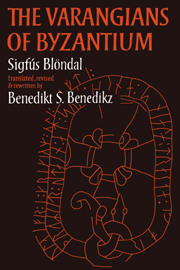Book contents
- Frontmatter
- Contents
- Illustrations
- Preface
- 1 Varangians and their origins
- 2 The army and navy of the High Byzantine Empire
- 3 Norse and Russian forces in the Byzantine army to the death of Romanos III
- 4 Haraldr Sigurðarson and his period as a Varangian in Constantinople, 1034–1043
- 5 The Varangians between 1042 and 1081
- 6 Varangians during the period 1081–1204
- 7 The ghost of the regiment: Varangian evidences 1204–1453
- 8 The Emperor, his Court, his guards and his city
- 9 Some individual Norse and English Varangians and travellers to Byzantium
- 10 Runic inscriptions concerning Varangians
- Select bibliography
- Index
1 - Varangians and their origins
Published online by Cambridge University Press: 19 October 2009
- Frontmatter
- Contents
- Illustrations
- Preface
- 1 Varangians and their origins
- 2 The army and navy of the High Byzantine Empire
- 3 Norse and Russian forces in the Byzantine army to the death of Romanos III
- 4 Haraldr Sigurðarson and his period as a Varangian in Constantinople, 1034–1043
- 5 The Varangians between 1042 and 1081
- 6 Varangians during the period 1081–1204
- 7 The ghost of the regiment: Varangian evidences 1204–1453
- 8 The Emperor, his Court, his guards and his city
- 9 Some individual Norse and English Varangians and travellers to Byzantium
- 10 Runic inscriptions concerning Varangians
- Select bibliography
- Index
Summary
This book is intended to examine the history of the section of the Byzantine armed forces which went in its heyday under the name of Væringjar (Varangians). It is, however, necessary to precede the main history with a brief outline of their origins, and especially to outline the historical and geographical conditions which led to their appearance in the East Roman army.
From the earliest known times Scandinavians have been attracted to Russia on commercial enterprises, especially in search of furs for clothing and, for a long period, of slaves. This traffic originated mainly in Sweden, the country with the most direct access to Russia, especially from Uppland, East Götland and the island of Gotland; the maritime districts of Uppland and East Götland being known in early times as Roþer or Roþin, and later as Roslagen (W. Norse Róðrslög), and the inhabitants were named Róðskarlar, Róðsmen, and lastly, Roðsþiggar. These people formed the bulk of the Russia traders and they began in time to form settlements in the East; thus the part of the Finnish coast nearest to Sweden was originally settled from there, and is still the Swedish-speaking portion of Finland, whose inhabitants are known in Finnish as Ruotsalaiset, and in Swedish as Ruotsi. As time went by their numbers increased in Russia proper so that Norse writings refer to the northern and central parts of Russia as Suiþjóð en mikla (Great Sweden) or Suiþjóð en kalda (Cold Sweden) to distinguish them from Sweden proper.
- Type
- Chapter
- Information
- The Varangians of Byzantium , pp. 1 - 14Publisher: Cambridge University PressPrint publication year: 1979



